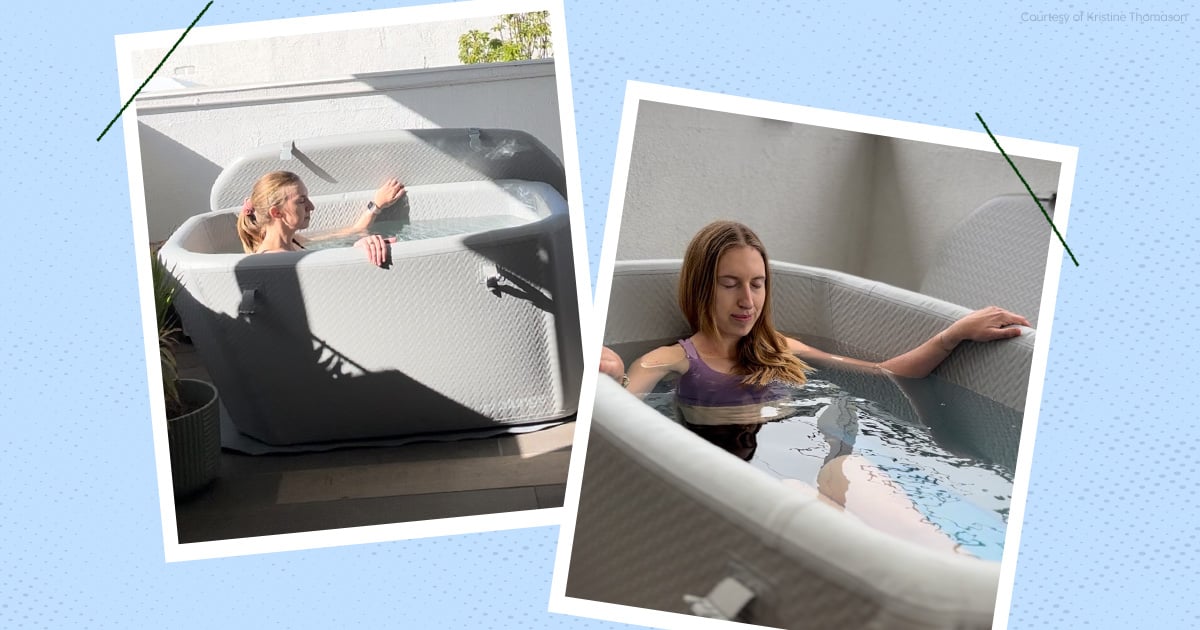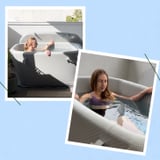I’m sitting in a tub of 38 degree water, on an uncharacteristically chilly day in Southern California, doing my best to steady my breathing, and questioning all of my life choices.
How did I get here, you ask? A month ago, I began wondering whether my precious daily cup of coffee was exacerbating my stress. For context, I’m in the throes of wedding planning, and let’s just say that emotions have felt heightened as a result.
Over the years, a number of my friends have ditched coffee, and they’ve found it helped quell some of their anxiety symptoms. I’ve been intrigued by their anecdotal experience. But, to be honest, my love of coffee eclipsed my curiosity. Not to mention, I’m hardly a morning person, so the idea of starting my day without any kind of caffeine boost sounded both miserable and unrealistic.
Meanwhile, I’ve been increasingly interested in cold water therapy (aka cold plunging, cold showers, etc.) This practice is nothing new (in fact, it’s been part of Scandinavian traditions for over a thousand years), but it’s recently been getting extra buzz in the wellness world and on social media. As a health journalist, I’ve had the opportunity to investigate some of the potential benefits of cold plunge – such as reducing inflammation, supporting immune function, helping with perceived soreness after a workout, etc. – and the topic fascinated me.
Over the last year I embraced this wellness practice whenever I had the opportunity: I dipped into chilly tubs at health clubs like Remedy Place and Pause Studio in Los Angeles, took part in a traditional sauna/cold plunge experience in Norway, and even dove into the Pacific Ocean mid-winter. After each of these experiences, I noticed that I felt invigorated, accomplished, and pretty damn euphoric.
Then, one day, I thought I might apply it to my morning routine: What if I traded my daily cup of coffee with a cold plunge?
The Research
As a journalist, I wasn’t about to go into this self-experiment without concrete rationale to back me up. So I chatted with Christopher Minson, PhD, Professor of Human Physiology at University of Oregon, to get his take.
While there’s currently not enough research to confirm that cold plunging definitively improves your mental health, Dr. Minson says people can experience stress reduction and a psychological boost after trying it. In fact, in a recent study on the effects of cold water immersion, Dr. Minson and his team of researchers found that cortisol levels (the “stress hormone”) dropped for participants after doing cold water immersion for 15 minutes, and remained that way for three hours afterward. Plus, researchers also concluded it may benefit mental health, overall.
From a physiological perspective, the benefits make a lot of sense to Dr. Minson – especially if you’re able to dunk your head under the water. When the nerve receptors in our face get really cold, it triggers our parasympathetic nervous system, which decreases stress and could improve our heart rate variability, Dr. Minson explains.
“I suspect if we did direct nerve recordings of the sympathetic nervous system, we’d see some reductions there as well,” he adds. “There’s something about cold stress that makes them more relaxed.”
Part of that effect, he believes, also has to do with a sense of accomplishment. When you’re finished a cold plunge, it can feel like you’ve successfully conquered a challenge, which is a pretty uplifting way to start your day, Dr. Minson says. He also notes that this mentality may snowball into other positive choices that support your physical and mental – like opting for more nutritious foods, getting more exercise, etc. As for alertness and energy, Dr. Minson says there’s “no doubt a cold blast can make you feel more awake.”
When I asked Dr. Minson about my coffee swap plan he thought it was worth a try and suggested submerge my body up to my neck, starting with two minutes in the tub and working my way up from there (noting there’s no real benefit to going over 15 minutes).
With some expert reassurance that I wasn’t completely off base about the potential benefits, I moved forward with my self-imposed challenge.
The Challenge
First things first, I needed to figure out my cold plunge setup. I don’t have a backyard, but I do have a large balcony with plenty of space for a tub. I opted to try out the new Plunge Air, which is an inflatable and portable version of the brand’s popular porcelain tub. It has an optional chiller add-on, which I used, that cools the tub to as low as 38 (yes, 38!) degrees.
My plan: Wake up in the morning, go for a little walk or any other morning movement (running, strength training, etc.), then hop in that tub before breakfast.
The first day was challenging, to say the least. I went through my morning routine, then mentally prepared to brave the icy water. I consulted the readout on the chiller: 38 degrees. Check. Then I made the mistake of sticking my hand in the water, inciting immediate hesitation. After a few moments of self-encouragement, I set a timer on my watch for two minutes, then hopped into the tub, with just my running shorts and a sports bra shielding me from the chill.
Immediately, my breathing quickened and I had to fight the urge to jump out. I focused on breathing in through my nose, and out through my mouth. I tried to slow the cadence with every breath I took, and turned my attention to that rhythm (rather than the prickly cold that swept across my legs and torso). After about 30 seconds, I settled into my breath and began to actually feel a sense of calm. It was similar to the sensation I get while meditating – my brain began to quiet, and I found myself fully present.
I checked my watch: One minute down, and one to go. The cold water was much less noticeable at this point, and I allowed myself to just embrace it. At the two minute mark, I pushed myself out of the tub and observed that all of my exposed skin was now lobster red. I wrapped myself in a towel and ran to take a hot shower.
Here’s the thing: You know what sounds pretty fantastic after you spend a couple minutes in icy water? A nice piping cup of coffee. So for the second day, I decided to add a new steaming, comforting beverage to my life in the morning. I combined a bit of ginger with bone broth, and drank a warm cup each morning after my plunge. This brew has its own potential health benefits, so it felt like a nice complementary practice (even if I did feel like baby Yoda clutching my little mug of broth).
For the next week, I continued to do the plunge for two minutes every day. I expected to have pretty nasty coffee withdrawals. However, beyond one headache early in the week, I surprisingly didn’t have any other symptoms.
While I decided to cap my time in the tub at three minutes, there were some days when I opted to plunge twice: once in the morning and once in the afternoon.
The plunging itself also got easier. I found as the week went on, I was able to regulate my breath much more rapidly and just embrace the chill (in every sense of the word). At the end of that first week – in which I didn’t dip below my chest – I decided to go for my first full head dunk. And wow, Dr. Minson wasn’t kidding about that one. Similar to jumping in a cold lake or ocean, I felt slapped awake – and ready to take on the day.
In the weeks that followed, I leveled-up my plunge and worked my way up to a full three minutes. Each day, it felt easier and easier, and I actually started to look forward to morning dip. While I decided to cap my time in the tub at three minutes, there were some days when I opted to plunge twice: once in the morning and once in the afternoon.
It was particularly nice after a run or challenging strength workout especially since I noticed my legs felt pretty recovered the next day. As for stress levels, I didn’t notice much of a difference at first. However, by the end of the month, I started to feel less anxious in the morning. Instead, I experienced a pretty steady calm that seemed to wash over me in the tub and last throughout much of the day.
That said, energy-wise, while I’d feel great for a few hours, it began to wane a bit by the afternoon. I know it’s common for people to hit a mid-afternoon slump – but that’s not a phenomenon I regularly experience, so it was a bit jarring. Perhaps the plunge made me a bit too calm? Maybe my body was ready for some rest and digest after a long era of fight or flight? I may need a bit more research to know for certain.
The Path Forward
The overall verdict: I think I’m officially a cold plunging fiend.
It might sound unhinged, but I genuinely did start to look forward to my morning plunge. Feeling the cold water wash over me and choosing to accept it rather than fight it is an incredibly empowering experience. This mindful part of my routine started to feel like another form of meditation in my day – one that my mind and body both welcomed. Perhaps it’s my Northern European roots, but my body really seemed to embrace the cold much more than I anticipated.
That said, I have to be honest: I genuinely missed my morning coffee. I missed the taste, I missed the little extra cognitive boost, and I missed the ritual of sipping a cup with my partner in the morning (as a coffee aficionado, he makes a stellar pour over).
So rather than continuing to ditch coffee entirely, I think there’s a hybrid scenario in my future. I talked to my doctor about it, and she recommended keeping up with the morning plunge to see the longer-term effects. And, at the same time, coffee can still be part of the equation. However, she suggested I decrease the amount of coffee I have each morning, either by diluting it with milk, having a smaller serving, or even switching to some decaf.
What’s crucial, I learned, is to be mindful of all forms of stressors in our lives. As Dr. Minson points out, before introducing any kind of stressor (positive or not) it’s important to be aware of how much stress a person already has in their life. While adding a healthy “micro-stressor” like cold plunging may be positive for some, it might be too much for others. It’s all about finding the right balance for you as an individual. For me, that might mean reducing my coffee intake during high-stress wedding planning and physically stressful half marathon training – and making space to add in a healthy stressor like cold plunging. For others, adding on any kind of stressor might simply be too much.
What’s more, some people absolutely dread cold plunging, and it causes them significant distress to even think about sitting in an icy tub. In that case, it might be counterproductive to add cold plunging to your daily routine.
At the end of the day, nothing is a magic pill – despite what social media may lead you to believe. The key is to get better acquainted with your own body, and learn what makes you feel your absolute best. That might mean a little bit of experimenting or simply a healthy dose of mindfulness. In any case, I’ll be over here submerging my body in cold water every day in the name of science. Stay chill, friends.
Kristine Thomason is a lifestyle writer and editor based in Southern California. Previously, she was the health and fitness director at Mindbodygreen and the fitness and wellness editor at Women’s Health. Kristine’s work has also appeared in POPSUGAR, Travel + Leisure, Men’s Health, Health, and Refinery29, among others




